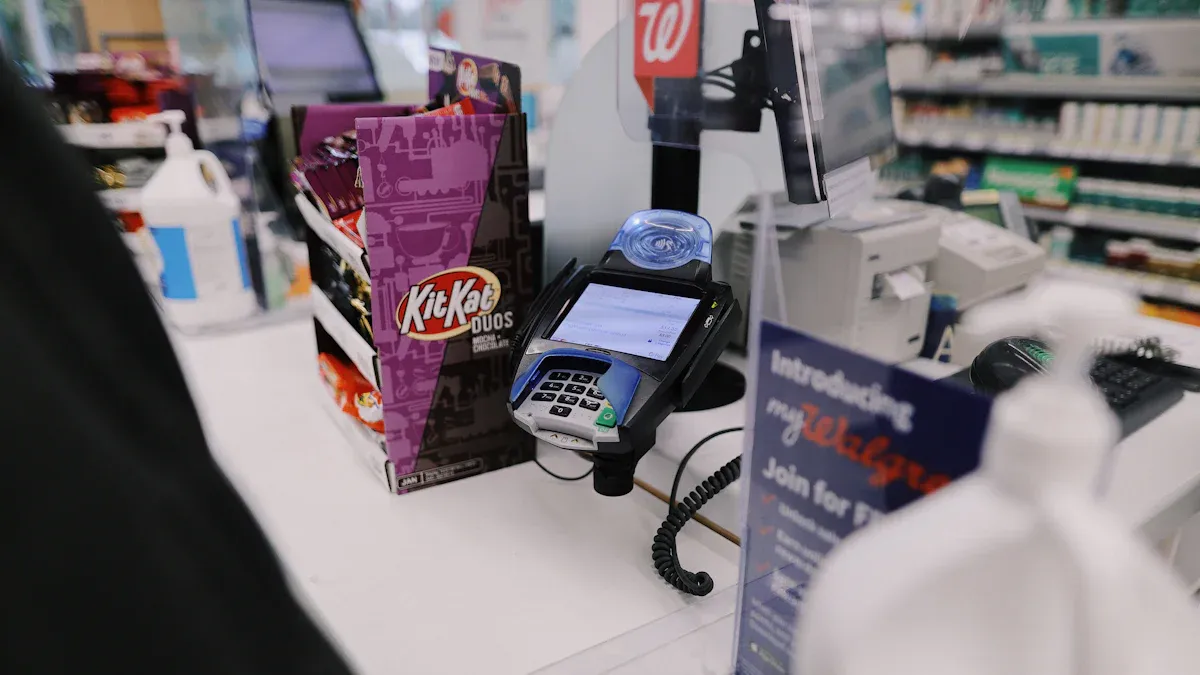Walmart Self-Checkout Access: What’s Changing in 2025?

Walmart is transforming its self-checkout experience in 2025 by introducing enhancements to its self-checkout lanes, with a focus on prioritizing Walmart+ subscribers and Spark delivery drivers. Over 50% of shoppers expect self-service kiosks, and 70% of retail executives believe that features like Walmart Self-Checkout boost customer loyalty. This change aligns with the growing demand for automation in retail.
Key Takeaways
Walmart plans to use invisible barcodes in 2025. This will make scanning items faster from any angle.
AI systems will watch self-checkouts to stop theft and work better.
Only Walmart+ members and Spark drivers can use self-checkout. Non-members might wait longer in lines.
What’s New in Walmart Self-Checkout for 2025?

Invisible barcodes for seamless scanning
Walmart is introducing invisible barcodes to its self-checkout lanes, a feature designed to make your checkout process faster and easier. These barcodes, developed in partnership with Digimarc, are embedded directly into product packaging. You no longer need to search for traditional barcodes, as the system scans items from any angle. This innovation speeds up the checkout process for both customers and employees, reducing wait times in checkout lines.
Invisible barcode technology has already proven its effectiveness in retail. For example, grocery retailers using this technology have reported improved efficiency and reduced waste. With over 66% of retailers shifting resources toward convenient checkout options, Walmart’s adoption of this feature reflects its commitment to enhancing your shopping experience.
AI-powered monitoring systems for enhanced security
Walmart’s self-checkout system will also include AI-powered monitoring to improve security and efficiency. These systems analyze transactions in real time, identifying unusual activities to prevent theft. They also monitor employee behavior to detect potential fraud. By operating discreetly, AI ensures a secure environment without disrupting your experience.
AI technology offers additional benefits, such as predictive analytics and data integration. It forecasts risks by analyzing historical data, helping Walmart prepare for potential disruptions. This approach not only strengthens security but also enhances the overall self-checkout experience.
Limited self-checkout access for select users
Walmart plans to limit self-checkout access to certain groups, such as Walmart+ subscribers and Spark delivery drivers. This change aims to prioritize loyal customers and streamline the self-checkout approach. However, limited access could lead to longer wait times for others, potentially affecting customer satisfaction. Speed remains a key factor, as two-thirds of consumers cite it as their primary reason for using self-checkout kiosks.
By focusing on select users, Walmart hopes to create a more efficient system. This shift aligns with the growing demand for self-service kiosks and reflects Walmart’s efforts to adapt its self-checkout policy to meet consumer preferences.
Why Walmart is Updating Its Self-Checkout System
Combating theft and fraud with advanced technology
Walmart is addressing theft and fraud by integrating cutting-edge technology into its self-checkout process. Self-checkout machines often experience theft rates up to four times higher than traditional lanes. To combat this, Walmart is using AI-powered solutions that analyze real-time data to detect suspicious behavior. These systems cross-check visual data with scanned barcodes, reducing fraud while maintaining accuracy.
Retailers like Walmart, Target, and Costco are also testing scaled-back self-checkout systems to improve security. Some stores have implemented item limits to minimize shrinkage. These changes reflect a growing need for advanced tools to protect inventory and ensure a smooth checkout process for you.
Improving efficiency and reducing checkout times
Walmart’s updated self-checkout process focuses on speed and efficiency. Self-checkout systems significantly reduce wait times, allowing you to complete your shopping faster. These systems also enable one employee to manage multiple kiosks, improving productivity.
Next-generation self-checkouts, powered by AI and computer vision, enhance operational efficiency. They streamline customer flow and prevent bottlenecks, ensuring a seamless experience. Studies show that faster self-checkout services lead to higher customer satisfaction and loyalty. By adopting these improvements, Walmart aims to make your shopping experience more convenient.
Aligning with customer feedback and preferences
Walmart’s shift toward updated self-checkout options aligns with customer preferences. Surveys reveal that 79% of retailers believe self-checkout improves the shopping experience. Customers value the speed and convenience these systems offer.
Retailers are also adapting self-checkout systems to be more inclusive. For example, some updates make the process friendlier for individuals with autism spectrum disorder (ASD). By listening to feedback, Walmart ensures its checkout options meet your needs while enhancing store layouts and space utilization.
How These Changes Will Impact Shoppers
Benefits of faster and more secure self-checkout
The updated Walmart self-checkout system brings several advantages to your shopping experience. AI-powered technology ensures smoother transactions by reducing theft and fraud, which improves overall satisfaction. Self-checkouts also shorten lines and wait times, making your visit more efficient. Studies show that these systems speed up transactions by 30%, allowing you to complete your purchases faster.
Retailers like Walmart can now use labor more effectively. One employee can oversee multiple kiosks, which lowers operating costs and keeps the process running smoothly. You also gain the flexibility to choose between a quick self-checkout or in-person assistance, depending on your preference. This balance aligns with the growing demand for convenience in retail.
Potential challenges for non-subscribers or traditional shoppers
While the new self-checkout policy prioritizes Walmart+ subscribers, it may create hurdles for others. Non-subscribers could face longer wait times or limited access to self-checkout lanes. Traditional shoppers might struggle with the technology, leading to frustration or abandoned purchases.
Some common challenges include scanning errors and a lack of staff to assist when issues arise. These problems can disrupt the checkout process and leave you feeling dissatisfied. Studies reveal that self-checkout systems often alienate shoppers unfamiliar with the technology, impacting their overall experience.
Adjustments required for a smoother shopping experience
To adapt to these changes, you may need to familiarize yourself with the updated self-checkout options. Retailers like Walmart monitor system performance to improve efficiency and reduce intervention rates. By leveraging data, they aim to enhance your interaction with the technology.
Flexible self-checkout policies can also help by increasing transaction points and processing speed. As a shopper, staying informed about these updates ensures a more seamless experience. Retailers continue to refine these systems to meet your needs and improve overall satisfaction.
Walmart Self-Checkout vs. Cloudpick’s Unmanned Store

AI-driven innovations in Walmart’s self-checkout
Walmart’s self-checkout system incorporates advanced AI technologies to improve efficiency and security. These innovations automate inventory management, saving time and resources. AI algorithms detect fraudulent activities and monitor consumer behavior, ensuring a safer shopping environment. Additionally, real-time inventory updates help Walmart manage stock levels effectively, ensuring popular items remain available.
Generative AI plays a significant role in optimizing product data. It processes over 850 million data points, achieving results that would typically require a much larger workforce. This technology also enhances your shopping experience by improving product search capabilities and providing detailed descriptions. These advancements demonstrate how Walmart uses AI to streamline operations and enhance checkout availability for its customers.
Cloudpick’s Unmanned Store as a fully automated retail solution
Cloudpick’s Unmanned Store offers a cashier-less shopping experience powered by cutting-edge AI. These stores eliminate the need for scanning or cash handling, providing a seamless and efficient process. Real-time data analytics optimize inventory levels, ensuring shelves remain stocked and demand is met.
With over 200 stores in 13 countries, Cloudpick’s technology has proven its effectiveness globally. The system reduces labor costs while speeding up transactions, making it a cost-effective solution for retailers. Its AI-powered features also enhance customer satisfaction by offering a smooth and hassle-free shopping journey. Cloudpick’s Unmanned Store represents a significant change in how retail operates, focusing on convenience and efficiency.
Comparing customer experiences and operational efficiency
Both Walmart’s self-checkout and Cloudpick’s Unmanned Store prioritize speed and convenience. Surveys show that 73% of consumers prefer self-service options for a better shopping experience. Walmart’s AI-driven systems reduce wait times and improve security, while Cloudpick’s cashier-less approach eliminates traditional checkout steps entirely.
Customer satisfaction depends on ease of use and reliability. Walmart’s self-checkout provides flexibility, allowing you to choose between self-service and in-person assistance. Cloudpick’s Unmanned Store, on the other hand, offers a fully automated experience, ideal for tech-savvy shoppers. Both systems enhance operational efficiency, but Cloudpick’s global reach and advanced automation set it apart as a leader in cashier-less retail solutions.
Walmart’s self-checkout updates in 2025 showcase its dedication to innovation and customer satisfaction. These changes offer:
Operational flexibility, allowing systems to scale during peak times.
Improved staff productivity, enabling employees to focus on essential tasks.
However, adapting may require you to learn new systems. Solutions like Cloudpick’s Unmanned Store emphasize the future of seamless, automated shopping.
FAQ
1. How will Walmart’s self-checkout updates affect non-subscribers?
Non-subscribers may experience longer wait times or limited access to self-checkout lanes. Familiarizing yourself with traditional checkout options can help you adapt.
2. What makes Cloudpick’s Unmanned Store unique compared to Walmart’s self-checkout?
Cloudpick’s Unmanned Store eliminates scanning and cash handling entirely. Its AI-powered system offers a fully automated shopping experience, ideal for tech-savvy customers.
💡 Tip: If you prefer a cashier-less experience, explore Cloudpick’s Unmanned Store for seamless shopping.
3. Will Walmart’s AI-powered monitoring compromise your privacy?
No, Walmart’s AI systems prioritize security while protecting your privacy. They operate discreetly and focus on detecting theft or fraud without storing personal data.
See Also
Exploring Cloudpick Self-Checkout: Locations and User Feedback in 2025
Identifying Self-Checkout Cash Mistakes: Solutions for Seamless Payments
The Future of Retail: Embracing AI-Driven Store Innovations
How Cloudpick's Checkout Technology Boosts Efficiency and User Satisfaction
Transforming Retail: Cloudpick's Cashierless Solutions for Your Store
